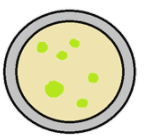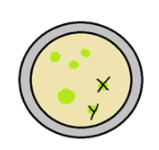
Lederberg’s replica experiment explains:
A. Lamarck’s Theory
B. Mutation Theory
C. Darwin’s Theory
D. None of the above
Answer
557.7k+ views
Hint: Lederberg experimented on antibiotic resistant bacteria. He tested out if the bacteria are going to develop any new adaptations to the environment given to them. But the result showed that strains of bacteria did not evolve the resistance to penicillin but instead had the ability even before the exposure to the same.
Complete answer:
-The experiment was led by scientists Joshua and Esther Lederberg in 1952.
-The motive or aim of the experiment was to study Darwin's Theory”.
-Darwin’s theory suggested that all organisms already have the adaptations to a certain environment and that they are not developed as a result of exposure to that certain environment.
-Joshua and Esther used ‘antibiotic- penicillin resistant’ bacteria strains to perform the experiment that throws light on Darwin's Theory.
-They spread the bacteria on a plate and called it “original plate”.
-Bacteria now grow on that plate to form ‘colonies’.
-After some time, different types of colonies can be seen on the plate.

-These colonies were now replicated on a ‘replica plate’ with the help of a method called “stamping”.
-Now, on the replica plate, the colonies were treated by “Penicillin”.
-The result they noticed was something like this:
Some colonies died because they did not have the resistance to antibiotic penicillin.
Some colonies survived because they had the penicillin resistant gene in them.
They named those colonies X and Y.

-Now they washed the ‘original plate’ with the same antibiotic i.e. penicillin.
-They noticed that the same colonies i.e. X and Y colonies on the original plate survived and the rest of the colonies died of the antibiotic.
-Hence they concluded that Darwin’s theory was correct.
-Mutations do not occur directionally but instead are random.
-Organisms already attain adaptations to certain environments and not because of the ‘exposure’.
-Just as the antibiotic resistant bacteria colony- X and Y had the resistance to the antibiotic even before their exposure to it.
Hence, the correct answer is option (C).
Note: Lamarck’s theory says that acquired characteristics i.e. the characteristics that we develop throughout our lifetime, for example- grown muscles through gym, can be passed onto our progeny. He hypothesized the theory studying the evolution in some organisms for example, giraffes. He proposed that in due course of time, a giraffe extended its limb and its neck, in order to eat the leaves on height, the extension was inherited into the germ cells of the organism and this resulted in passing on the trait to its progeny. Hence, evolution resulted in the extended limbs and neck of a giraffe.
Mutation theory was given by Hugo De Vries and the theory proposed that mutations occur discontinuously and suddenly in the gene of an organism due to environmental stimuli and that mutation is passed onto the progeny bringing evolution. This theory contradicted Darwin’s Theory which said that evolution took place due to variations that accumulated over a period of time and not all of a sudden.
Complete answer:
-The experiment was led by scientists Joshua and Esther Lederberg in 1952.
-The motive or aim of the experiment was to study Darwin's Theory”.
-Darwin’s theory suggested that all organisms already have the adaptations to a certain environment and that they are not developed as a result of exposure to that certain environment.
-Joshua and Esther used ‘antibiotic- penicillin resistant’ bacteria strains to perform the experiment that throws light on Darwin's Theory.
-They spread the bacteria on a plate and called it “original plate”.
-Bacteria now grow on that plate to form ‘colonies’.
-After some time, different types of colonies can be seen on the plate.

-These colonies were now replicated on a ‘replica plate’ with the help of a method called “stamping”.
-Now, on the replica plate, the colonies were treated by “Penicillin”.
-The result they noticed was something like this:
Some colonies died because they did not have the resistance to antibiotic penicillin.
Some colonies survived because they had the penicillin resistant gene in them.
They named those colonies X and Y.

-Now they washed the ‘original plate’ with the same antibiotic i.e. penicillin.
-They noticed that the same colonies i.e. X and Y colonies on the original plate survived and the rest of the colonies died of the antibiotic.
-Hence they concluded that Darwin’s theory was correct.
-Mutations do not occur directionally but instead are random.
-Organisms already attain adaptations to certain environments and not because of the ‘exposure’.
-Just as the antibiotic resistant bacteria colony- X and Y had the resistance to the antibiotic even before their exposure to it.
Hence, the correct answer is option (C).
Note: Lamarck’s theory says that acquired characteristics i.e. the characteristics that we develop throughout our lifetime, for example- grown muscles through gym, can be passed onto our progeny. He hypothesized the theory studying the evolution in some organisms for example, giraffes. He proposed that in due course of time, a giraffe extended its limb and its neck, in order to eat the leaves on height, the extension was inherited into the germ cells of the organism and this resulted in passing on the trait to its progeny. Hence, evolution resulted in the extended limbs and neck of a giraffe.
Mutation theory was given by Hugo De Vries and the theory proposed that mutations occur discontinuously and suddenly in the gene of an organism due to environmental stimuli and that mutation is passed onto the progeny bringing evolution. This theory contradicted Darwin’s Theory which said that evolution took place due to variations that accumulated over a period of time and not all of a sudden.
Recently Updated Pages
Master Class 12 Business Studies: Engaging Questions & Answers for Success

Master Class 12 Economics: Engaging Questions & Answers for Success

Master Class 12 English: Engaging Questions & Answers for Success

Master Class 12 Maths: Engaging Questions & Answers for Success

Master Class 12 Social Science: Engaging Questions & Answers for Success

Master Class 12 Chemistry: Engaging Questions & Answers for Success

Trending doubts
What are the major means of transport Explain each class 12 social science CBSE

Which are the Top 10 Largest Countries of the World?

Draw a labelled sketch of the human eye class 12 physics CBSE

Explain sex determination in humans with line diag class 12 biology CBSE

The pH of the pancreatic juice is A 64 B 86 C 120 D class 12 biology CBSE

Explain sex determination in humans with the help of class 12 biology CBSE




